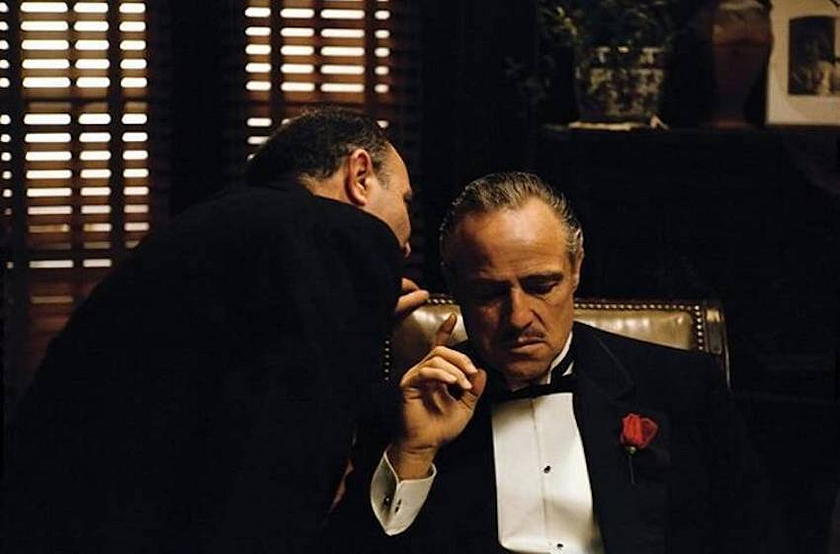THE GODFATHER and THE GODFATHER PART II
Egyptian Theatre
June 16, 2024
When I was 15, I pirated The Godfather (1972) on my Chromebook and fell asleep during the second act. I woke up to a black screen, gave the film five stars on Letterboxd, and never spoke of it again.
Now 20, now a MacBook owner, now a stipend-supported intern, I felt things could be different. I purchased tickets to Father’s Day screenings of The Godfather Part I and Part II and arrived at the Egyptian Theatre well rested.
The first film began, and I was immediately reeled in by 1940s New York on 35mm film; by the streets of Sicily roaring through surround sound; by Marlon Brando, his face lit from the side, his pupils dark, barely visible, but his presence reaching through the screen, causing all of us, in our hundreds, to gasp. This time, I had $7.00 (butter-free) popcorn, a 7 Up from home, and a stranger to my left who whispered his favorite lines along with the actors. I couldn’t have slept if I’d tried.
The Egyptian Theatre is an anachronism — immediately transportive, with a dirt-gold ceiling fixture that stretches out overhead, and more than 500 seats to sink into. Disappearing into mine, I found myself in a different world, a place where violence ruled the streets and things moved too quickly for me to object. The Corleones’ America is a lawless one. Perhaps the only place where a man in a three-piece can drag a man — his brother-in-law, mind you — in a bright orange suit through the streets, beat him against a wall, pummel him with a trash can, pour the trash over him, and then walk through a crowd of spectators untouched. Using a steady and often brutal escalation, the film primes its viewer to witness its violence. So by the time it arrived at massacre, though shocked, I almost approved.
When the first film was over, no one left. The theater stayed dark, and the credits rolled. When Francis Ford Coppola’s name appeared on-screen, the audience started to applaud. They clapped for the cast. They clapped for the crew. They clapped as if the artists were in the room with us. Spotting the composer’s name, Nino Rota, some people began to cheer. There was an hour between the two screenings, and those of us who were staying were asked to wait outside. It was 6:00 p.m. when we left the theater, and the sidewalks were packed with people pacing up and down Hollywood Boulevard. Standing in the reentry line, I watched them as the groups around me recounted the movie in great detail, noting how brave Michael Corleone had been, reflecting on the mafia war as though they’d lived through it.
In the members-only line, the father in a family of five said that it was time to take a picture. His three children shook their heads, asking him to not make a scene. “Come on,” he said. “It’s Father’s Day,” he said. “Is your father embarrassing you?” The man standing behind them offered to take the picture. He wore an unpressed T‑shirt and gray sweats and said there was nothing to be embarrassed about. The father and mother ducked under the red crowd-control rope. The three children walked around it. Posing for the photo, the father stood pointing up at the Egyptian Theatre sign. I texted my dad that I missed him.
Seated again, waiting for Part II (1974) to start, I noted that the two men to my left worked in Hollywood. The man one seat over had long, blond hair. The man two seats over’s blond hair was short. The short-haired blond was talking about a mutual friend who had just made it big, whose first film was produced for $700,000, and whose next film would be produced for $70 million. The long-haired blond turned bright red. “Wow,” he said, “wow,” curling his hair with a finger the whole time.
At a few points during Part II, the sound briefly dropped. Robert De Niro’s Vito Corleone would be walking through Sicily and the audio would flicker between orchestral and muffled, three or four times in the space of a minute. I looked around to see if anyone else had noticed, but the whole theater seemed to be smiling. The couple to my right had their arms around each other. The filmmakers to my left were leaning toward the screen. I repositioned myself and tried to focus. The sound rose, and I fell into the movie. It dropped, and I fell back out. But suddenly I, too, was smiling. I thought I understood. It was like we were being shuttled between two places: brought into Coppola’s world and then returned to ours, part of the chaos and then witnesses to it — like the magic of the movies came from being aware of their tricks.






